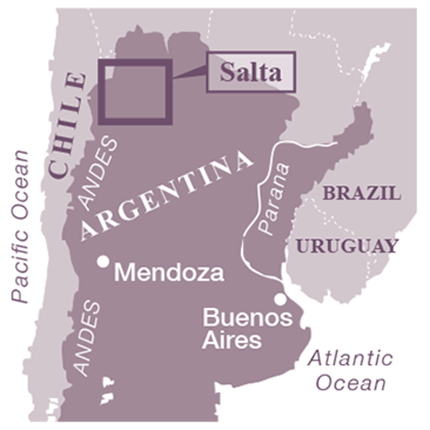Home to some of the world’s highest vineyards, this province in northwestern Argentina seduces millions of tourists each year with its wild and beautiful scenery, its rich cultural scene, and its delicious wines. Alejandro Iglesias acts as tour guide...
Salta travel guide
Salta fact file
Planted area: 3,050ha
Main grapes, red: Malbec, Cabernet Sauvignon, Tannat, Syrah, Cabernet Franc
Main grapes, white: Torrontés, Chardonnay, Sauvignon Blanc
Leading producers: Bodega El Esteco, Bodegas Etchart (Pernod Ricard), Finca Quara, Domingo Hermanos, Colomé/ Amalaya, El Porvenir de Cafayate, Nanni, San Pedro de Yacochuya, Piatelli, Domingo Molina, El Transito, Tacuil
Coops: just one
The province of Salta offers one of the most extreme wine routes in the world, along the Calchaquí Valleys. The backdrop is stunning, with dramatic, sweeping views of ravines, canyons and red mountain ranges. In addition to its natural wealth, Salta’s culture represents a priceless heritage. With strong pre-Columbian roots and criollo influence, Salta maintains many ancestral traditions that run through its art, its food, and the warmth of its people.
The heart of its wine industry is Cafayate, a small town in the Calchaquí Valleys, a three-hour drive from the capital city. The journey to Cafayate is a procession of magical postcard views. In order to enjoy it at your own pace, it is ideal to rent a vehicle, or choose a private shuttle service or tour.
The road passes through hills and arable land until the green colours turn reddish, and mountain rocks and cacti dominate the desert landscape. Welcoming you to the valleys is the De las Conchas ravine, a series of geological formations and a popular stop for photos.
Cafayate, which became the bastion of Salta’s wine industry during the 20th century, features the typical urban layout of colonial towns in the countryside. It is small, and everything happens around the central square, which is the favourite meeting spot among its residents.
Its vineyards are located between 1,600 and 2,100 metres above sea level, in a sunny, desert environment. The red wines are known for their structure and spice notes, mostly represented by Cabernet Sauvignon, Tannat and some Malbecs. Among the whites, Torrontés is king. The country’s flagship white variety features citric, floral and tropical aromas, and is mouth-tinglingly fresh.
Since the 1980s, Cafayate wineries have been producing world-renowned, high-end wines. The local wineries range from historic establishments to modern and innovative estates. All of them enjoy educating tourists in the secrets of high-altitude wines.
In order to learn about the history of Calchaquí wines, start by visiting Antigua Bodega Vasija Secreta, the oldest winery in the valley. Its museum (La Banda) traces the history of the wine industry in Cafayate since the late 19th century, through a collection of 300 artefacts. Another historic stop is Finca Quara, a winery recently upgraded by the Lavaque family. Its cellar contains a large collection of historic winemaking paraphenalia. Tourists are welcome for a short visit during the morning or afternoon, and can book special activities on request.
The colonial facade of Bodega El Esteco is a must-see. It’s the valley’s main producer and its oenologist, Alejandro Pepa, is the driving force behind an ambitious portfolio, introducing wines that are representative of high-altitude climates, like Altimvs and Chañar Punco.
At 2,000 meters above sea level, and 10 kilometres away from the main square, a very steep road leads you to the most famous spot in the area: Yacochuya. There, in 1988, Arnaldo Etchart and Michel Rolland founded San Pedro de Yacochuya, producer of the deep and lively Malbec that consolidated the image of the region at an international level. A few minutes away, Rafael Domingo leads the family winery Domingo Molina, offering wines that are true to the terroir. Especially worth tasting are the Tannat and Torrontés.
In the town’s centre, at the Porvenir de Cafayate winery, oenologist Mariano Quiroga, together with the American consultant Paul Hobbs, are betting on different terroirs in order to obtain better results for their Malbec, Tannat, and a Torrontés that promises to make history.
No trip to Cafayate is complete without visiting winemaker José Luis Mounier’s Finca Las Nubes. His knowledge of the high-altitude terroir made him the most consulted professional in the valley. In his small family winery, you must be sure to taste his legendary Torrontés and his Cabernet Sauvignon.
For those in search of other recreational activities, horse riding through the hills is a popular activity, and so are the expeditions through desert dunes on all-terrain vehicles. Leave some time to shop for locally crafted pottery, tapestries, knitted fabrics, and precious metal pieces in one of the town’s craft markets, so that you don’t return home empty-handed.
Andean cuisine is another major attraction in these valleys. The flavours come from a fusion between ancient recipes and criollo techniques. Empanadas are the perfect bite: filled with chopped beef, potato and bell peppers, they are small and very juicy. Other typical dishes include tamales, humitas en chala (flavoured corn paste wrapped in corn leaves), quinoa-based recipes and goat stews, as well as jams made with Calchaquí fruits, and the classic quesillo or curd cheese.
For those willing to extend their trip through this high-altitude wine route, the Molinos department, approximately 130km from Cafayate, is home to more wineries. The road to this destination offers more ravines, dry mountain rivers, and some inhospitable spots. It is a three-hour journey that is more than rewarded with the wines from the Colomé and Tacuil wineries, both growing vines at a jaw-dropping 2,500 metres above sea level.
How to get there
Martín Miguel de Güemes International Airport is located only 9km from central Salta, and 189km (about three hours) from Cafayate. It receives daily flights from within Argentina, with connections during the s Patios de Cafayate ummer to Brazil and Chile.
Alejandro Iglesias is a sommelier, wine writer and educator who co-founded the Argentinian wine app Vinomanos.







